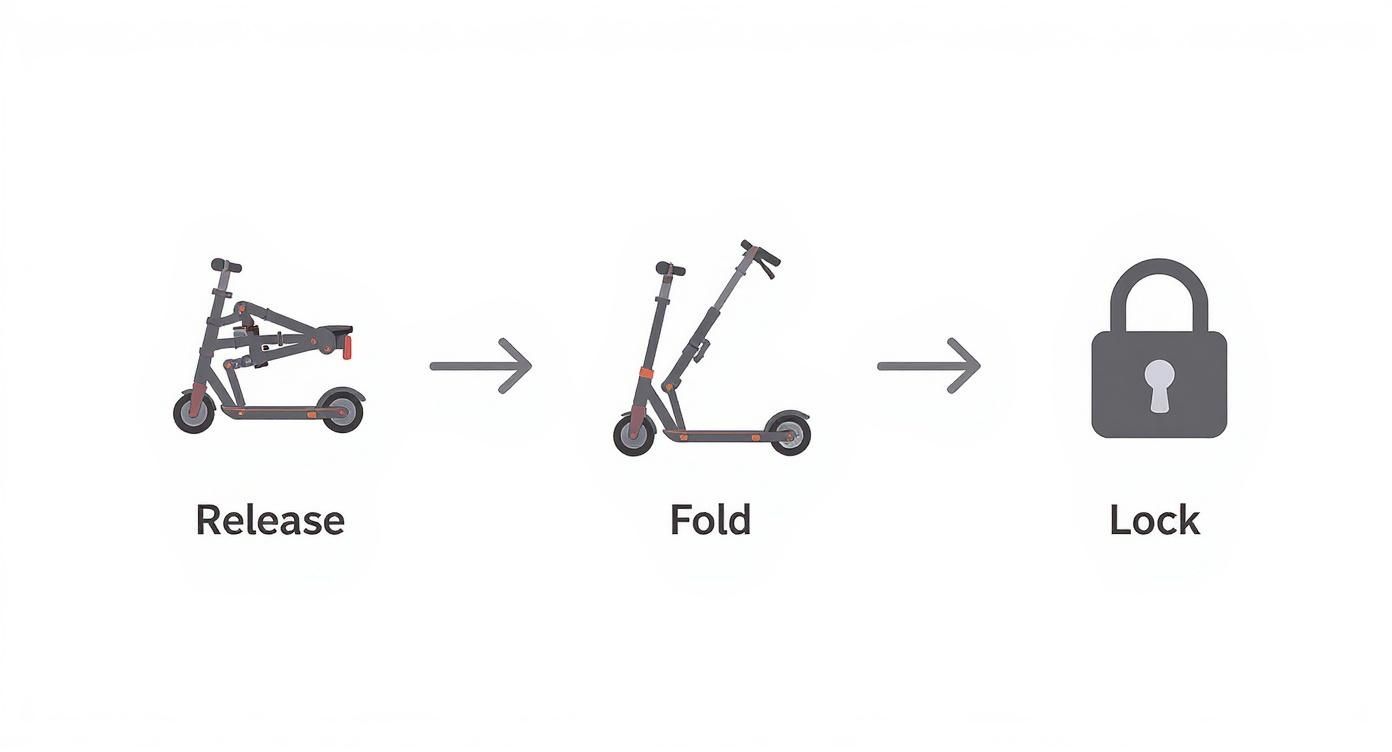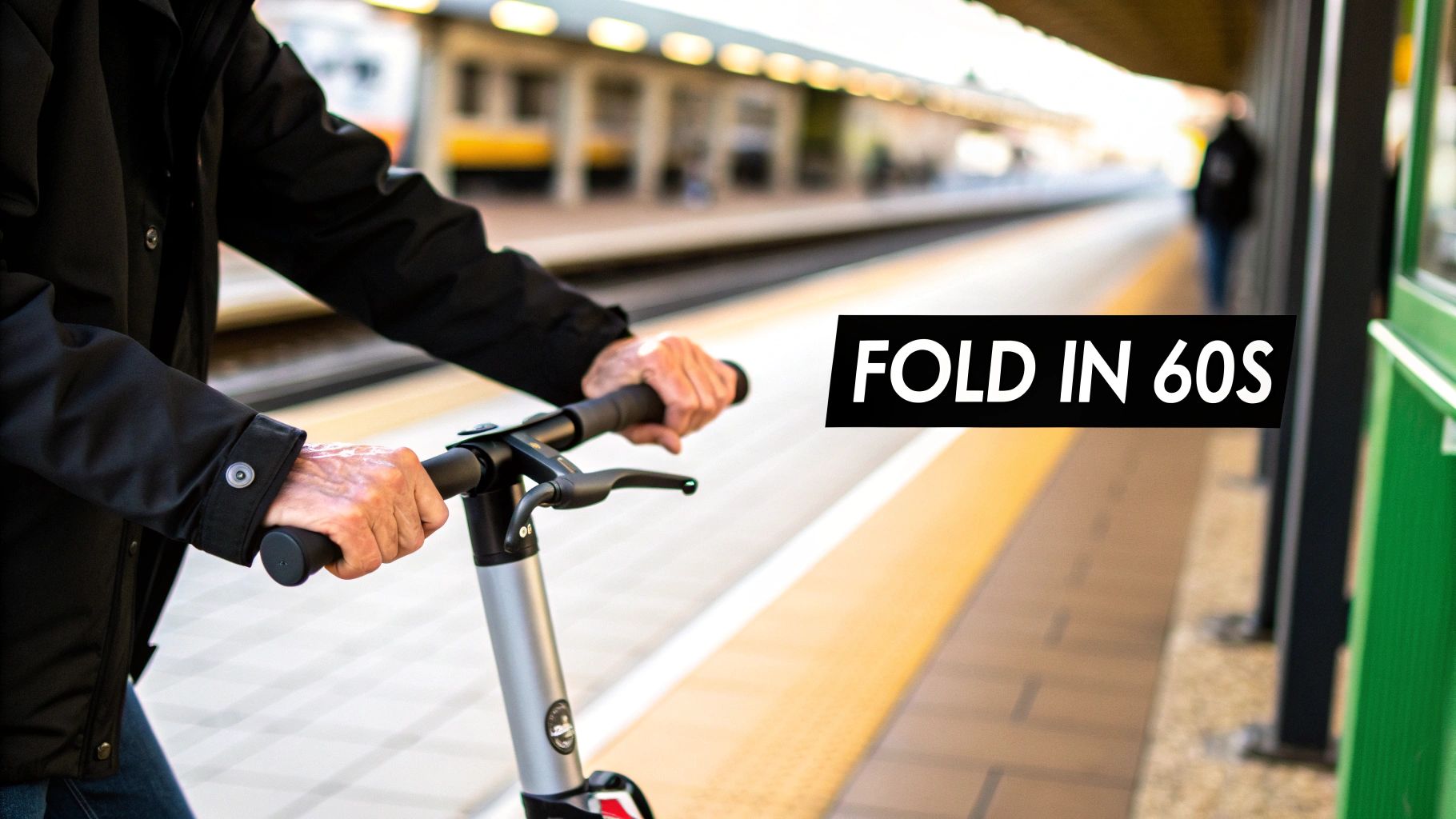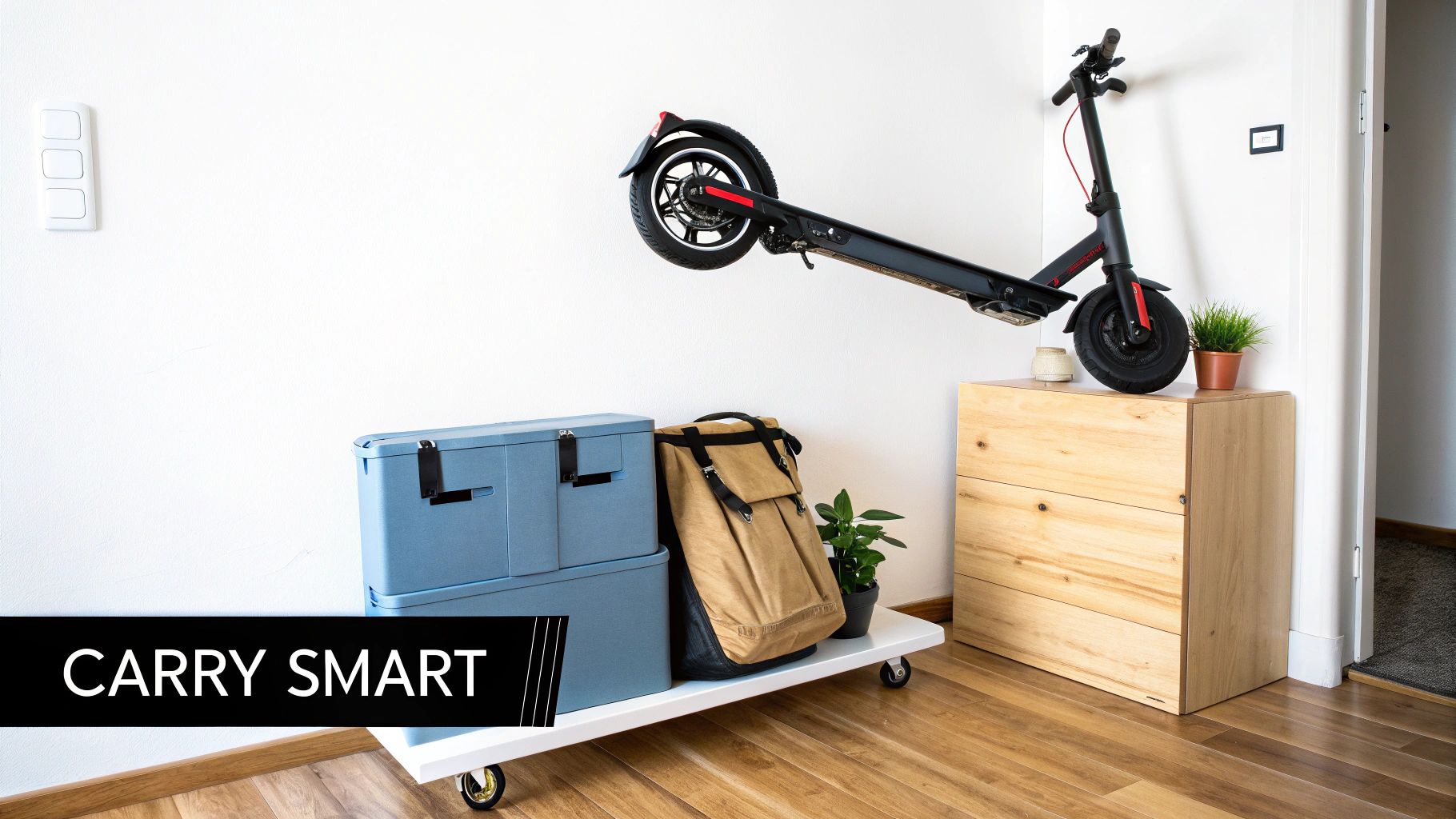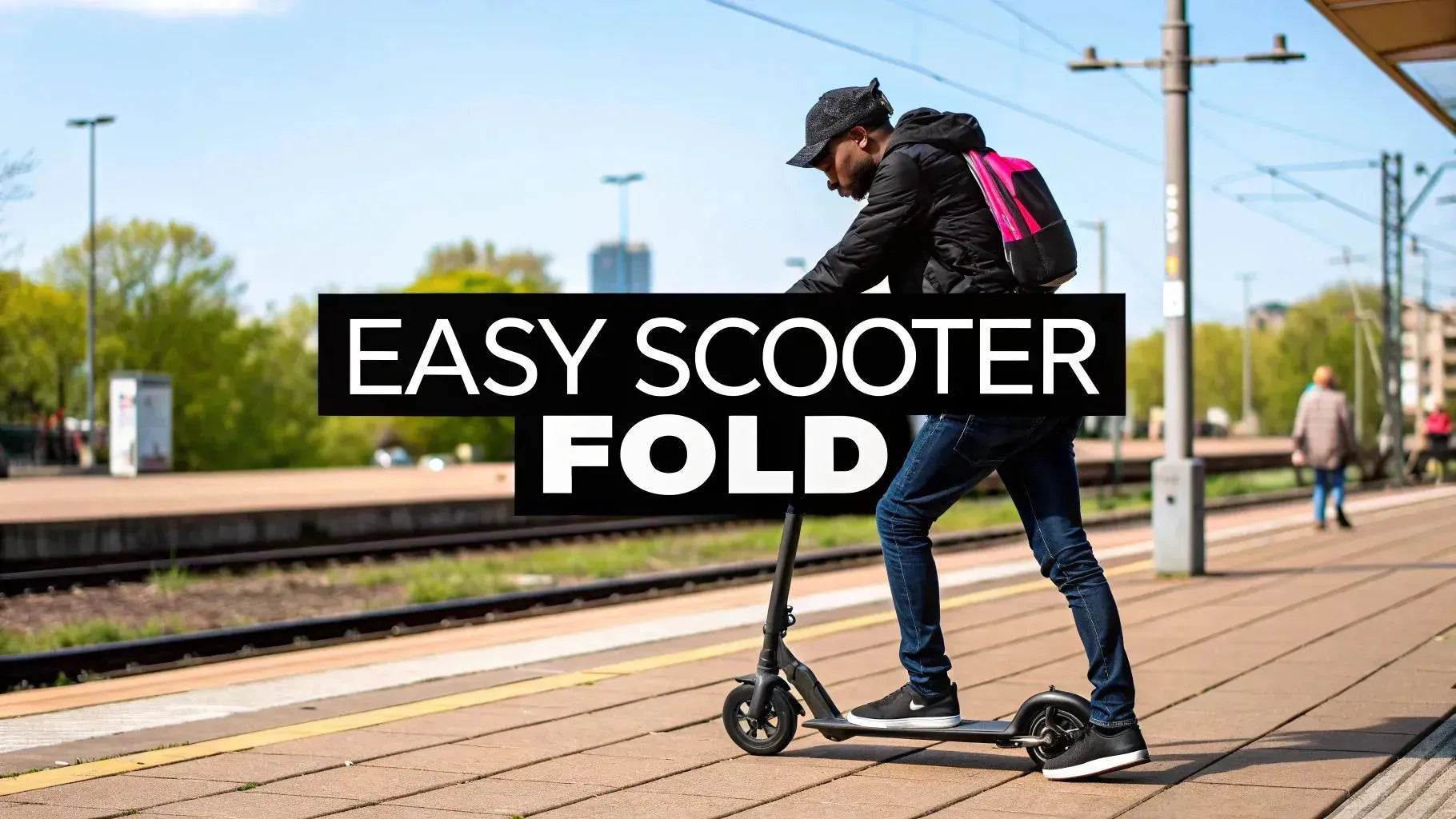Folding your scooter really just comes down to releasing a latch, folding the handlebar stem, and clicking it into place. The trick is figuring out your specific folding mechanism—it's usually a lever or a collar—and using firm, steady pressure to get it open.
Mastering the Basics of Folding Your Scooter
Ever found yourself fumbling with your scooter trying to get it folded before hopping on a bus in Los Angeles or a train in Chicago? You're not alone. It can feel a bit awkward at first, especially when you're in a rush during the morning commute.
The good news is that once you get the hang of it, folding your scooter becomes second nature. We're talking less than a minute. The whole process boils down to three core movements that are surprisingly consistent across almost every model out there, from lightweight commuter scooters popular in cities like Sydney and Melbourne to the beefier models you see across the United States.
This guide isn't like those confusing manuals. Think of it as some friendly advice to get your scooter from ready-to-ride to folded-and-stowed, minus the frustration.
The Three-Step Folding Flow
No matter the brand, most electric scooters follow the same basic folding sequence. The parts might look a little different, but the logic is always there.

This visual breaks it down perfectly. You disengage the lock, you do the fold, and you secure it. Simple as that.
Every scooter has to be unlocked before it'll fold. Some throw in an extra safety button you have to press at the same time, but the core action doesn't change. Getting this fundamental process down is the key to a quick, seamless fold every single time.
Common Scooter Folding Mechanisms at a Glance
While the "unlock, fold, secure" principle is universal, the hardware can vary. Here’s a quick look at the most common types of folding systems you'll encounter on popular models in the US and Australia.
| Mechanism Type | Primary Action | Common On Models |
|---|---|---|
| Lever-Style Latch | Flip or pull a single lever, often with a safety pin. | Commuter scooters (e.g., Segway-Ninebot, Glion) |
| Collar-Style Latch | Twist or slide a ring-like collar around the stem. | Some premium or heavy-duty models |
| Button/Hook System | Press a button and hook the stem to the rear fender. | Lightweight and ultra-portable scooters (e.g., Unagi) |
This table should help you quickly identify what you're working with. Once you know the mechanism, you're halfway there.
A smooth fold isn't about brute force; it’s about technique. Applying pressure in the right spot makes all the difference. For example, slightly pushing the handlebars forward can release tension on the latch, making it much easier to open.
Getting to Know Your Scooter's Folding Mechanism

Before you try to fold your scooter, you’ve got to figure out what you’re working with. Not all folding systems are the same, and knowing which one your ride has is the first step to doing it right—and without wrestling with it in public.
It’s no surprise there are so many different designs out there. The global electric scooter market was worth a massive USD 17.73 billion in 2023 and is only getting bigger as cities embrace smarter ways to travel. All that growth means tons of innovation in how these things fold. You can dive deeper into the booming e-scooter market on Fortune Business Insights.
The Classic Lever and Latch
This is the bread and butter of folding mechanisms. If you have a popular commuter scooter, like a Segway-Ninebot or Glion, you’ve probably got one of these. It's usually a single lever right at the base of the handlebar stem.
The trick here isn't brute force. Look for a small safety button or pin you need to disengage first. Once that's free, give the main lever a firm pull. Here’s a pro tip: gently push the handlebars forward as you pull the lever. This takes the strain off the joint and lets it release smoothly.
The Secure Collar System
A little less common but super sturdy, the collar system is often found on higher-end or more rugged scooters. Instead of a lever, there’s a sleeve or "collar" that you twist or slide to unlock the stem.
These can feel a bit stiff when they're new. The key is to get a good grip and give it a confident twist. If it’s not budging, try wiggling the handlebars back and forth a tiny bit. That usually frees up just enough tension for the collar to release.
Listen for the 'Click' That satisfying, sharp click you hear when folding or unfolding isn't just a nice sound—it's your confirmation that everything is locked securely in place. If you don't hear it, it's not safe to ride or carry. Always double-check.
Multi-Step Safety Mechanisms
If you've got a beast of a scooter built for high speeds or off-roading, chances are it has a more complex folding system. These are all about safety, often using a mix of pins, levers, and collars.
With these, the sequence is everything. Trying to muscle through it in the wrong order will get you nowhere. For example, you might have to:
- First, pull out a spring-loaded safety pin.
- Then, while holding the pin, release the main lever.
- Finally, guide the stem down until it clicks into a second lock on the deck.
Folding the Most Common Scooters in the US and Australia
Alright, let's move past the theory and get our hands dirty. Knowing the general idea of folding a scooter is great, but every model has its own little personality. Getting the hang of your specific scooter’s quirks is what makes the difference between fumbling around at the station and a swift, smooth fold.
Popular brands you see all over the US and Australia—like Segway-Ninebot, Glion, and Unagi—all have their own take on the folding mechanism.
This is where a bit of insider knowledge helps. For instance, with a Segway-Ninebot KickScooter, a slight nudge forward on the handlebars is the secret to releasing tension on the latch, making it pop open effortlessly. Try that on another brand, and you might just be standing there confused. It's this kind of hands-on detail that really matters.
The Segway-Ninebot Trick
As one of the giants of the American and Australian scooter scenes, Segway-Ninebot often uses a very similar, and frankly, pretty smart folding system. You’ll usually find a lever-style latch at the bottom of the handlebar stem, which is kept in place by a small safety lock or ring. The whole thing is simple once you know the rhythm.
- Deal with the Safety Lock First: Look for a little rotating collar or a small button right on the main lever. You have to slide or twist that little guy out of the way before the main latch will even think about moving.
- The Gentle Nudge: This is the key. As you start to pull the main lever down, give the handlebars a gentle push away from you. This simple move releases the tension and stops you from having to wrestle with the mechanism.
- Fold, Click, and Go: Now, just guide the stem down toward the back of the scooter. On many of their models, the bell on the handlebar is actually designed to hook right into a catch on the rear fender. Listen for that solid click—that’s how you know it’s locked and ready to carry.
How to Fold an Unagi or Glion Scooter
Brands like Unagi and Glion are hugely popular in the US for their focus on sleek, ultra-portable design. Their folding mechanisms reflect this, often being incredibly fast and simple, sometimes using a one-click button system.
For an Unagi Model One, for example, you're dealing with a simple push-button hinge. Press the button firmly with your thumb, and the stem folds down smoothly. Glion models often feature a foot-activated pedal near the base. Just step on it, pull back on the handlebars, and it collapses. These systems are designed for speed, perfect for the commuter who needs to fold and go in seconds.
The real secret to a fast fold? Repetition. Seriously, just practice it a few times at home when you’re not in a rush for a bus or train. You’ll build muscle memory and soon you’ll be doing it without even looking.
Getting to know the specific design of your scooter makes all the difference. If you're still in the market and trying to decide which one is for you, check out our comprehensive electric scooter buying guide. It can help you compare all the key features, including how easily different models fold up, so you can find one that genuinely fits into your daily life.
Essential Safety Checks Before and After You Fold
Okay, so you’ve mastered the fold. That’s great, but it's only half the story. Making sure it’s securely folded is what really counts. A wobbly latch is a recipe for disaster, whether you're lugging your scooter up a flight of stairs or it decides to spring open on a packed train.
These little checks take just a few seconds, but they're absolutely vital for your safety and for keeping your scooter in good shape. Think of it as building good habits that will prevent nasty surprises and protect your ride for the long haul.
Before You Even Start Folding
First thing's first: give the folding mechanism a quick once-over. Do you see any dirt, grit, or gunk jammed in the joint? Especially after a dusty ride or a sudden downpour, it’s amazing how much grime can build up in there.
Even a tiny piece of gravel or some packed-in dirt can stop the latch from clicking home properly, leaving you with a weak lock that could fail at any moment. A quick wipe with a finger or a bit of cloth is all it takes to avoid a massive headache later on.
Pro Tip: Your scooter's folding mechanism should be smooth, not a wrestling match. If you have to force it, something’s wrong. Stop, check for blockages, and make sure you haven't missed a release button.
After It's Folded Solid
Once the stem is down and you think it’s locked, you need to be 100% sure. The best way I’ve found is a quick two-part test using your ears and hands.
- Listen for the 'Click': That crisp, audible click is your first sign that everything is seated correctly. Don't move on until you hear it.
- Give It a Gentle Tug: Sound isn't enough. Grab the handlebars and give them a firm but gentle pull away from the deck. It should feel completely solid with zero movement or wobble.
This simple physical check gives you the confidence that your scooter is actually locked and safe to carry. If you want to brush up on other critical checks, our full guide on essential electric scooter safety tips is a must-read before you head out.
Now, Where Do You Put It? Smart Ways to Store and Carry Your Folded Scooter
Okay, you’ve mastered the fold. Now what? A folded scooter is only as good as how easily you can stash it or lug it around. The whole point is convenience, so let's make sure it doesn't feel like you're wrestling with a piece of machinery.
First things first, find its balance point. Don't just grab the stem and hope for the best. Feel along the frame for that sweet spot where the weight feels even. Getting this right makes a world of difference when you’re hauling it up a flight of stairs or hopping on public transit. Your back will thank you.
Clever Storage for Squeezing into Small Spaces
Let's be real, most of us don't have a ton of extra space, especially in an urban apartment in New York or a suburban home in Australia. Leaving a scooter by the front door is a recipe for a trip hazard. Luckily, there are some great ways to keep it tucked away.
- Vertical Stands: These are a lifesaver. You can slide your scooter into a tight corner or a closet, and it takes up hardly any floor space.
- Wall Mounts: Why not turn your ride into wall art? A solid wall mount gets it completely off the ground and out of the way. It looks pretty cool, too.
- Carry Bags: If you're a commuter, a carry bag is non-negotiable. It makes the scooter so much easier to handle and stops you from getting grease or road grime all over your clothes and the floor of your car or office.
These little tricks make your scooter feel like a seamless part of your home, not a clumsy obstacle. If portability is a huge deal for you, you should check out our guide on the best lightweight electric scooters—they're even easier to manage.
Quick tip: Always store your scooter somewhere dry and at a reasonable temperature. Leaving it in a humid garage or a freezing cold entryway overnight is terrible for the battery's health and can seriously shorten its lifespan.
This level of convenience is a huge part of why e-scooters are exploding in popularity. Seriously, the global market is expected to hit an eye-watering USD 321.59 billion by 2034. It's all because people are looking for practical, green ways to get around. You can dig into the numbers yourself with these electric scooter market trends and projections on Precedence Research.
Got Questions About Folding Your Scooter?

Even after you’ve folded your scooter a dozen times, you can still run into a few head-scratchers. Let's tackle some of the most common issues riders come across.
One of the biggest frustrations? A stuck latch. It's tempting to just yank on it, but don't. Before you use brute force, try gently pushing the handlebars forward a little. This simple move often releases just enough tension on the joint to free it up.
If that doesn't work, check for any gunk or debris jamming the mechanism. A quick clean can solve a lot of problems. Still stuck? A small shot of a silicone lubricant, like WD-40 Specialist Silicone, can be a real lifesaver.
Unfolding Without Surprises and Other Pro Tips
Unfolding can sometimes feel a bit… aggressive. You release the latch, and the whole thing springs open with a jarring clank. To avoid this, keep a firm grip on the handlebars and control the stem as you unlock it. Just guide it up smoothly instead of letting it fly open on its own.
People often ask about long-term storage, too. Is it okay to leave a scooter folded? For short periods, absolutely. But if you're putting it away for a while, it's actually better to store it unfolded. This prevents the cables from getting pinched or strained, which is just healthier for the scooter in the long run.
A little preventative care goes a long way. To keep that folding mechanism working like a charm, keep it clean and hit it with a light lubricant every few months. This tiny bit of maintenance prevents stiffness and ensures you're never wrestling with your scooter in a busy hallway.
Storing your scooter folded for a week-long vacation is perfectly fine. For longer periods, like over the winter, unfolding it helps preserve the integrity of the internal wiring and control cables, preventing unnecessary stress.
It’s pretty amazing how much the technology behind these folding systems keeps getting better. This is all part of a massive trend in the electric two-wheeler world. The industry was valued at USD 39.6 billion in 2025 and is expected to rocket to USD 110.6 billion by 2034. That kind of growth is what pushes manufacturers to create smarter, more user-friendly designs. You can dig into more of these trends in the electric motorcycle and scooter market report on gminsights.com.
Ready to find a ride that fits your life perfectly? Explore the incredible selection of electric scooters and bikes from top brands at Punk Ride LLC and transform your commute. Visit us today at https://www.punkride.com.





Share:
How to Lock Up a Scooter and Beat the Thieves
How to Make an Electric Bike Faster: Quick Upgrades